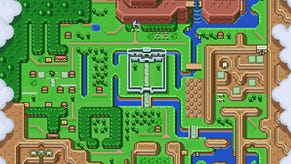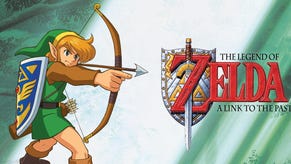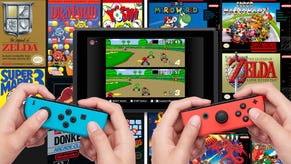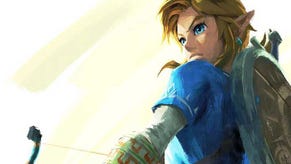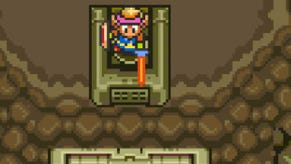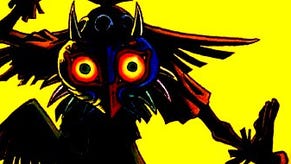Super NES Retro Review: The Legend of Zelda: A Link to the Past
Join us as we review every Super NES Classic game. Today: The Zelda game that changed everything.
This article first appeared on USgamer, a partner publication of VG247. Some content, such as this article, has been migrated to VG247 for posterity after USgamer's closure - but it has not been edited or further vetted by the VG247 team.
Join us as we review all the games on the SNES Classic Mini Edition in chronological order!
It's been over 25 years since The Legend of Zelda: A Link to the Past came to the Super Nintendo. That's two decades and some change. Five console generations. A quarter of a century – and I've still yet to play another game with an opening scene that's half as intense.
Whenever I start a new game of Link to the Past, I never rush through its first moments. Zelda's ominous, telepathic message to Link pairs up beautifully with the storm rumbling outside the cabin he shares with his uncle. Link's uncle, likewise sensitive to Zelda's mental pleas, sets out into the monsoon with a final warning to his nephew: Don't leave the house.
Luckily, the old man can't tell you what to do. He's not your REAL dad.
Link plops out of bed, grabs the lantern stowed beside the table, and charges into the belly of the storm. And that's the opening minute of the best Legend of Zelda game of all time.
It's never easy to rank Zelda titles, mind you. There's always some biting and scratching over the top three spots, which are typically reserved for A Link to the Past, Ocarina of Time, and Majora's Mask (I'm curious to see where Breath of the Wild falls in the next decade).
Link to the Past is inarguably a near-perfect specimen of game evolution, though. The first Zelda game for the NES forms the core of its DNA, which is a great start. Then it adds layers to its story, gameplay, graphics, and sound until it blossoms into one of the best action-adventure games of all time.
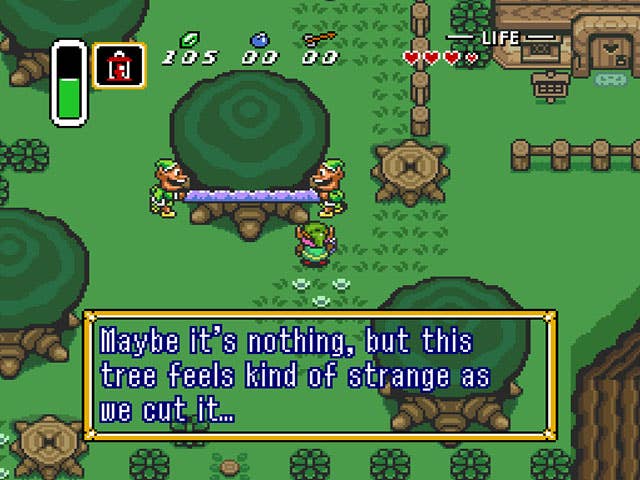
Though later Zelda games offer cooler items, better combat, trickier dungeons, and more imaginative enemies, I've yet to play another title in the series that's as well-paced as A Link to the Past. There's no trace of the slow start that 3D Zelda games became infamous for (a flaw Breath of the Wild rectified, thankfully). The aforementioned storm at the beginning of the adventure spurs you towards Princess Zelda, whom you rescue in the first hour of your adventure. The heaviness of Link's very first task is a notable switch from The Legend of Zelda and Zelda II, which make princess-saving Link's end goal.
Link is then instructed to explore Hyrule's overworld and several dungeons to fetch the McGuffins that free the Master Sword from its pedestal. With the Master Sword in-hand, Link cuts down the evil wizard that's plaguing the peaceful land of Hyrule—
But that's just the beginning.
Though A Link to the Past never really makes a secret out of the Dark World, entering Hyrule's twisted twin realm for the first time is a bit of a shock. You're offered a taste of the land's shadowy magic quite early in the game, when Link stumbles into a portal on Death Mountain and is turned into a bunny who's helpless to wield a weapon. While exploring the face of Dark World's Death Mountain as a timid rabbit is overwhelming by itself (especially since you even catch a glimpse of your end goal, Ganon's Tower, looming menacingly on its summit), it's nothing compared to entering the Dark World for keeps and discovering you have eight more dungeons to work through. The three you clear on the light side of Hyrule to win the pendants and the right to wield the Master Sword are just a baby-step towards lasting peace – like taking a trip to the hardware store to secure the wrench you need to fix a gushing pipe.

Nintendo clearly knows it created something special with A Link to the Past's "Light World prep / Dark World struggle" formula, because it used the same blueprint for Ocarina of Time and Twilight Princess. Interestingly, while I appreciate what Nintendo was aiming for with its successive uses of the mechanic, nothing tops entering the Dark World, checking my map, and seeing the blinking markers that indicate the size of the job in front of me. Even better is knowing that the Dark World itself is teeming with secrets. There are cervices and caves everywhere that hide Rupees, heart pieces, and even stories from unfortunate innocents and scoundrels who were pulled into the Dark World and transformed by its magic.
What's more, A Link to the Past's dungeons are perfectly-sized. They're not too short, and not too long. Each one is based on a unique gimmick. Sometimes you explore tall towers that require you to take leaps of faith down to lower levels (quite a mind-blowing experience if you ascend to A Link to the Past through the first two NES games), sometimes you flood corridors to swim across gaps, and sometimes you slip-and-side through a network of pipes. Many of the items you find in A Link to the Past's labyrinths have since gained a permanent place in Link's arsenal, and by extension, pop culture: The hook shot, the mirror shield, and the Fire Rod are as much a part of the Zelda series as swords and faeries.
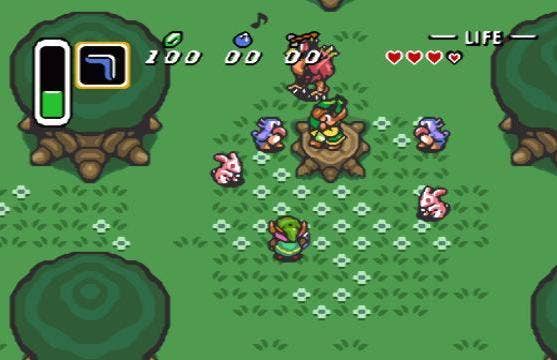
The release of A Link to the Past marks such a monumental moment in the beloved series' history that it feels petty to pick at the game's flaws. Nevertheless, there are a couple. While the game's backgrounds still look fantastic (the faux-3D effect used in castles and dungeons literally adds a noticeable new dimension to the flat environments of the first Zelda game), character and enemy sprites look kind of plain. Bosses are likewise dull outside of the mammoth Helmasaur King and Vitreous, that nasty-gross pile of eyeballs that rules over Misery Mire's dungeon.
It'd also be nice if each dungeon in A Link to the Past had its own theme. The game's soundtrack is incredible on its own, of course – The Silly Pink Rabbit is one of my favorite pieces of game music, ever – but I'd like something besides Dungeon of Shadows to accompany me while I'm walking around in circles looking for that last key.
If you want to fire the hookshot at the back of my head for even bothering to grouse about A Link to the Past's miniscule problems, I don't blame you. It's a brilliant adventure that forever changed the Zelda series, and action-adventure games in general. Its inclusion alone justifies the asking price for the SNES Classic Edition.
ConclusionThe Legend of Zelda: A Link to the Past is superb. If you haven't played it yet, beg your ancestors' preferred deity for forgiveness, then get down to work. What's that? You've already finished A Link to the Past 30 times? That's great. Make it 31 times.


